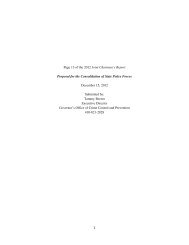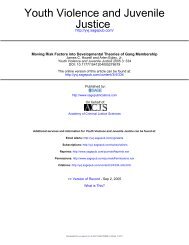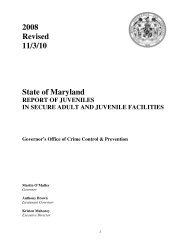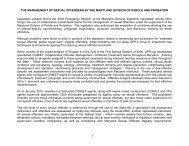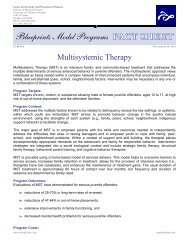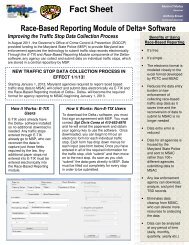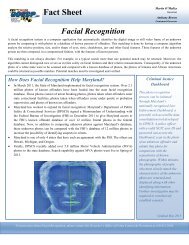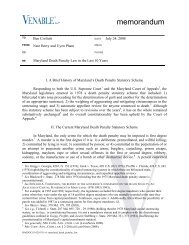The Cost of the Death Penalty in Maryland - Urban Institute
The Cost of the Death Penalty in Maryland - Urban Institute
The Cost of the Death Penalty in Maryland - Urban Institute
You also want an ePaper? Increase the reach of your titles
YUMPU automatically turns print PDFs into web optimized ePapers that Google loves.
sample are predictable, but have not yet occurred. <strong>The</strong>se costs are costs associated with<br />
<strong>in</strong>carceration, and are described <strong>in</strong> <strong>the</strong> next section.<br />
<strong>Cost</strong> <strong>of</strong> Prison<br />
Many <strong>in</strong>dividuals <strong>in</strong> <strong>the</strong> sample were <strong>in</strong> prison at <strong>the</strong> time data were collected for this study.<br />
Thus, <strong>in</strong>dividual prison costs <strong>in</strong>clude a retrospective component – how much time has already been<br />
spent <strong>in</strong> prison (and how much <strong>of</strong> that time has been spent on death row) – and a forecasted<br />
component – an estimate <strong>of</strong> how much time any <strong>in</strong>dividual will spend <strong>in</strong> prison until <strong>the</strong>y ei<strong>the</strong>r<br />
complete <strong>the</strong>ir sentence or die. Because we cannot observe when <strong>in</strong>mates died, when <strong>the</strong>y will die,<br />
or when <strong>the</strong>y will be released from prison, we estimate an expected date <strong>of</strong> exit from prison for each<br />
<strong>in</strong>mate predicted by <strong>in</strong>dividual attributes (<strong>in</strong>clud<strong>in</strong>g sentence length). Past prison costs were<br />
estimated <strong>in</strong> constant 2007 dollars. Future costs were estimated us<strong>in</strong>g forecasted rates <strong>of</strong> <strong>in</strong>creases <strong>in</strong><br />
spend<strong>in</strong>g and were discounted at a rate <strong>of</strong> 5% per year. <strong>The</strong> prison cost estimates are based on<br />
observed costs <strong>of</strong> prison <strong>in</strong> <strong>Maryland</strong> for both general prison populations and death row <strong>in</strong>mates.<br />
Prison cost estimates are adjusted to account for prison and health care <strong>in</strong>flation. Methods used to<br />
estimate lifetime prison costs for each <strong>in</strong>dividual <strong>in</strong> our sample can be found <strong>in</strong> Appendix A.<br />
METHODS<br />
Multivariate models were used to estimate <strong>the</strong> lifetime costs <strong>of</strong> cases as a function <strong>of</strong> capital<br />
punishment as well as case characteristics. <strong>The</strong> analysis proceeded <strong>in</strong> three stages.<br />
• In <strong>the</strong> first stage, we account for <strong>the</strong> fact that we were unable to observe data <strong>in</strong> our sample<br />
for every case <strong>in</strong> our population <strong>of</strong> <strong>in</strong>terest. In order for <strong>the</strong> cases with data to be<br />
comparable to <strong>the</strong> cases where data are miss<strong>in</strong>g, we generated weights so <strong>the</strong> sample data<br />
resemble <strong>the</strong> population <strong>of</strong> all death penalty cases between 1978 and 1999. A logistic<br />
regression was specified <strong>in</strong> order to generate sampl<strong>in</strong>g weights. <strong>The</strong>se weights are used <strong>in</strong><br />
all analyses. <strong>The</strong> explanatory power <strong>of</strong> <strong>the</strong> model (R 2 = 0.44) was high, <strong>in</strong>dicat<strong>in</strong>g that <strong>the</strong><br />
econometric model is able to accurately predict whe<strong>the</strong>r or not cases were complete. We<br />
found no difference <strong>in</strong> <strong>the</strong> probability that cases with a death notice had complete data.<br />
<strong>The</strong>se weights were used <strong>in</strong> all subsequent analyses.<br />
• In <strong>the</strong> second stage, we accounted for potential differences between cases where a death<br />
notice was filed and cases where no death notice was filed. By model<strong>in</strong>g <strong>the</strong> prosecutor’s<br />
decision to file a death notice, we account for <strong>the</strong> possibility that cases that received a death<br />
notice might have been more costly even if <strong>the</strong>re had been no death statute. A second<br />
logistic regression model was utilized to model <strong>the</strong> prosecutor’s decision to file a death<br />
notice. <strong>The</strong>se models yielded a propensity score – <strong>the</strong> probability that a case received a<br />
death notice conditional on that case’s attributes – for each case <strong>in</strong> our sample. <strong>The</strong><br />
propensity scores were <strong>the</strong>n used <strong>in</strong> outcome models to reduce any potential bias result<strong>in</strong>g<br />
from differences <strong>in</strong> death notice and no death notice cases. Variables <strong>in</strong>cluded <strong>in</strong> <strong>the</strong><br />
<strong>The</strong> <strong>Cost</strong> <strong>of</strong> <strong>the</strong> <strong>Death</strong> <strong>Penalty</strong> <strong>in</strong> <strong>Maryland</strong><br />
19



